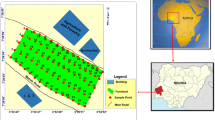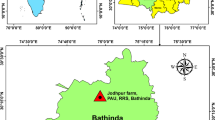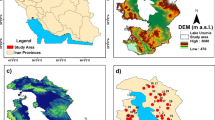Abstract
Soil moisture is one of the most important variables which affects different aspects of human life such as agriculture, flood, landslide, water resources, etc. There are different methods for modeling soil moisture such as conceptual, empirical and physically based models. Conceptual and physically based models are robust but they need several different data and information. However data driven models can be run using limited number of data. In this study, four data driven models i.e. MLP, ANFIS, SVR and GMDH were used to model soil moisture. Particle Swarm Optimization technique was used to optimize the structure of the four aforementioned models. Several different remote sensing-based indices were calculated using Landsat Imagery e.g. NDVI, TVDI, VTCI and TVX. An extensive field survey was conducted to collect soil moisture data in the region. A 70/30 ration was used to separate train and test data. 30 additional samples were used for a final validation of produced maps. Results showed a relatively poor performance of PSO-MLP model. The performance of PSO-ANFIS and PSO-SVR was moderate with R2 of 0.74 and 0.84 and RMSE of 3.4% and 3.1%, respectively. PSO-GMDH had a superior performance with R2 of 0.91 and RMSE of 2.4%. Therefore, PSO-GMDH can be suggested as a powerful modeling approach to produce soil moisture maps.









Similar content being viewed by others
Data availability
Not applicable.
Code availability
Not applicable.
References
Aminzadeh M, Or D (2013) Temperature dynamics during nonisothermal evaporation from drying porous surfaces. Water Resour Res 49(11):7339–7349
Armaghani DJ, Raja R, Faizi K, Rashid A (2017) Developing a hybrid PSO-ANN model for estimating the ultimate bearing capacity of rock-socketed piles. Neural Comput Appl 28(2):391–405
Azimi S, Dariane AB, Modanesi S, Bauer-Marschallinger B, Bindlish R, Wagner W, Massari C (2020) Assimilation of Sentinel 1 and SMAP – based satellite soil moisture retrievals into SWAT hydrological model: the impact of satellite revisit time and product spatial resolution on flood simulations in small basins. J Hydrol 581:1879–2707
Bartels GK, Castro NMR, Pedrollo O, Collares GL (2021) Soil moisture estimation in two layers for a small watershed with neural network models: assessment of the main factors that affect the results. CATENA 207:105631. https://doi.org/10.1016/j.catena.2021.105631
Bartsch A, Balzter H, George C (2009) The influence of regional surface soil moisture anomalies on forest fires in Siberia observed from satellites. Environ Res Lett 4(4):1–9
Chun-Ling L, Sheng H, Tsung-Ying S, Chan-Cheng L (2006) Cluster distance factor searching by particle swarm optimization for self-growing radial basis function neural network. Neural Netw 32:4825–4830
Eberhart R, Kennedy J (1995) A new optimizer using particle swarm theory. Micro Machine and Human Science, Proceedings of the Sixth International Symposium on, IEEE, pp. 39–43
Jang JSR (1993) ANFIS: adaptive-network-based fuzzy inference systems. IEEE Trans Syst Man Cybern Syst 23(3):665–685
Jang JSR, Sun CT, Mizutani E (1997) Neuro-Fuzzy and soft computing: a computational approach to learning and machine intelligence. Prentice-Hall, Upper Saddle River
Jiang L, Islam S (1999) A methodology for estimation of surface evapotranspiration over large areas using remote sensing observations. Geophys Res Lett 26(17):2773–2776
Kim SB, Liao TH (2021) Robust retrieval of soil moisture at field scale across wide-ranging SAR incidence angles for soybean, wheat, forage, oat and grass. Remote Sens Environ 266:112712. https://doi.org/10.1016/j.rse.2021.112712
Kisi O, Khosravinia P, Heddam S, Karimi B, Karimi N (2021) Modeling wetting front redistribution of drip irrigation systems using a new machine learning method: adaptive neuro- fuzzy system improved by hybrid particle swarm optimization – gravity search algorithm. Agric Water Manag 256:107067. https://doi.org/10.1016/j.agwat.2021.107067
Kumar SV, Peters-Lidard CD, Santanello JA, Reichle RH, Draper CS, Koster RD, Nearing G, Jasinski MF (2015) Evaluating the utility of satellite soil moisture retrievals over irrigated areas and the ability of land data assimilation methods to correct for unmodeled processes. Hydrol Earth Syst Sci 19(11):4463–4478
Massari C, Brocca L, Barbetta S, Papathanasiou C, Mimikou M, Moramarco T (2014) Using globally available soil moisture indicators for flood modeling in Mediterranean catchments. Hydrol Earth Syst Sci 18(2):839–853
Michalikova M, Prauzek M, Koziorek J (2015) Impact of the radial basis function spread factor onto image reconstruction in electrical impedance tomography. IFAC-PapersOnLine 48(4):230–233
Moosavi V, Talebi A, Mokhtari MH, Hadian MR (2016) Estimation of spatially enhanced soil moisture combining remote sensing and artificial intelligence approaches. Int J Remote Sens 37(23):5605–5631
Muller J, Ivachnenko A, Lemke F (1998) Gmdh algorithms for complex systems modelling. Math Comput Model Dyn Syst 4(4):275–316
Nguyen H, Moayedi H, Foong LK, Al Najjar HAH, Jusoh WAW, Rashid ASA, Jamali J (2019) Optimizing ANN models with PSO for predicting short building seismic response. Eng Comput 36:823–837
Peng J, Tanguy M, Robinson EL, Pinnington E, Evans J, Ellis R, Cooper E, Hannaford J, Blyth E, Dadson S (2021) Estimation and evaluation of high-resolution soil moisture from merged model and Earth observation data in the Great Britain. Remote Sens Environ 264:112610. https://doi.org/10.1016/j.rse.2021.112610
Priestley CHB, Taylor RJ (1972) On the assessment of surface heat flux and evaporation using large scale parameters. Monthly Weather Review 100:81–92
Rostami A, Arabloo M, Esmaeilzadeh S, Mohammadi AH (2018) On modeling of bitumen/n-tetradecane mixture viscosity: application in solvent-assisted recovery method. Asia Pac J Chem Eng 13(1):e2152. https://doi.org/10.1002/apj.2152
Sadeghi M, Jones SB, Philpot WD (2015) A linear physically-based model for remote sensing of soil moisture using short wave infrared bands. Remote Sens Environ 164:66–76
Seneviratne SI, Corti T, Davin EL, Hirschi M, Jaeger EB, Lehner I (2010) Investigating soil moisture–climate interactions in a changing climate: a review. Earth Sci Rev 99(3):125–161
Seo E, Lee M, Reichle RH (2021) Assimilation of SMAP and ASCAT soil moisture retrievals into the JULES land surface model using the Local Ensemble Transform Kalman Filter. Remote Sens Environ 253(12):112222. https://doi.org/10.1016/j.rse.2020.112222
Sivanandam S, Deepa S (2008) Principal of soft computing, 3rd edn. Wiley India, New Delhi
Tang R, Li ZL, Tang B (2010) An application of the Ts–VI triangle method with enhanced edges determination for evapotranspiration estimation from MODIS data in arid and semi-arid regions: implementation and validation. Remote Sens Environ 114(3):540–551
Tian J, Qin J, Yang K, Zhao L, Chen Y, Lu H, Li X, Shi J (2021) Improving surface soil moisture retrievals through a novel assimilation algorithm to estimate both model and observation errors. Remote Sens Environ 112802. https://doi.org/10.1016/j.rse.2021.112802
Vapnik V (1998) Statistical learning theory. Wiley-Interscience, New York
Viterbo P, Betts AK (1999) The impact on ECMWF forecasts of changes to the albedo of the boreal forests in the presence of snow. J Geophys Res Atmos 104(22):27803–27810
Zeyliger AM, Muzalevskiy KV, Zinchenko EV, Ermolaeva OS (2021) Field test of the surface soil moisture mapping using Sentinel-1 radar data. Sci Total Environ 151121. https://doi.org/10.1016/j.scitotenv.2021.151121
Zhang D, Li ZL, Tang R, Tang BH, Wu H, Lu J, Shao K (2015) Validation of a practical normalized soil moisture model with in situ measurements in humid and semi-arid regions. Int J Remote Sens 36(19):5015–5030
Zhu B, He C, Liatsis P (2012) A robust missing value imputation method for noisy data. Appl Intell 36(1):61–74
Author information
Authors and Affiliations
Contributions
Negin Behnia: Data curation; Investigation; Methodology; Software; Writing - original draft; Visualization
Mohammad Zare: Formal analysis; Data curation; Methodology
Vahid Moosavi: Conceptualization; Supervision; Validation; Writing - review & editing
Seyed Jamaleddin Khajeddin: Formal analysis; Data curation
Corresponding author
Ethics declarations
Ethics approval
Not applicable.
Consent to participate
Not applicable.
Consent for publication
Not applicable.
Conflicts of interest/Competing interests
Not applicable.
Additional information
Communicated by: H. Babaie
Publisher’s note
Springer Nature remains neutral with regard to jurisdictional claims in published maps and institutional affiliations.
Rights and permissions
About this article
Cite this article
Behnia, N., Zare, M., Moosavi, V. et al. An inter-comparison of different PSO-optimized artificial intelligence algorithms for thermal-based soil moisture retrieval. Earth Sci Inform 15, 473–484 (2022). https://doi.org/10.1007/s12145-021-00747-7
Received:
Accepted:
Published:
Issue Date:
DOI: https://doi.org/10.1007/s12145-021-00747-7




